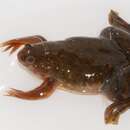en
names in breadcrumbs


This species can be found in the East African montane moorlands ecoregion, a specialized habitat occurring above 3000 meters in elevation in equatorial East Africa. Soils here are acidic and the climate is harsh, with year around nightly frost, accompanied by intense daytime solar insolation and heat. Glaciers cover the upper elevations of the ecoregion.
There are a number of endemic small mammals to the East African montane moorlands. One endemic mammal to the ecoregion is the Mount Kenya Mole Shrew (Surdisorex polulus), which is found only at the higher elevations of Mount Kenya; however, this Vulnerable Mole Shrew is not a strict associate, since its range is not overlapping with most of the animals of this ecoregion. The King Mole Rat (Tachyoryctes rex) is another endemic rodent to the ecoregion that is known only to the higher elevations of Mount Kenya within the ecoregion. The Vulnerable East African Highland Shrew (Crocidura allex) is a near endemic to the ecoregion, that is also found in upper elevation portions of the adjacent East African montane forests ecoregion. Another imputed endemic mammal to the ecoregion is Peter's Musk Shrew (Crocidura gracilipes).
A number of endemic anurans are found within the East African montane moorlands. The Marsabit Clawed Frog (Xenopus borealis) is a near endemic anuran, which is also found in the upper elevations of the adjacent East African montane forests ecoregion. Another near endemic amphibian is the Molo Frog (Amietia wittei), which is found only in the Kenyan central highlands and northern Tanzania in the East African montane moorlands and slightly lower in elevation in the East African montane forests. The near endemic Mountain Reed Frog (Hyperolius montanus) is found only in the Kenyan highlands of the ecoregion and also in the adjacent East African montane forests ecoregion. The Tigoni Reed Frog (Hyperolius cystocandicans) is a Vulnerable near endemic, found only in Kenya in this ecoregion and the adjacent East African montane forests.
The Mount Kenya Side-stripedChameleon (Triceros schubotzi) is an endemic reptile forund in the ecoregion; a second member of this genus, Triceros sternfeldi, is also endemic to the East African montane moorlands. The High-casqued Chameleon (Triceros hoehnelii) is a near endemic reptile to the East African montane moorlands; it is also found in higher elevations of the adjacent East African montane forests ecoregion. The Kenya Montane Viper (Montatheris hindii) is a near endemic that occurs only in the Kenyan part of the ecoregion and at slightly lower elevations in parts of the Kenyan East African montane moorlands.Special status reptiles found in the ecoregion include the Vulnerable Alpine Meadow Lizard (Adolfus alleni), a near endemic found only at high altitudes (above 2700 meters) on Mount Elgon, Mount Kenya, Cheragani Hills and the Aberdare Mountains.
There are a number of endemic plant groups within the ecoregion, likely driven by the extreme geographic isolation of these alpine patches. The giant groundsels are one prominent group of flowering plant species present; this unusual plant group achieves tree-like stature with some unusual methods of cold weather adaptation, even though they are members of the herbaceous family Asteraceae.
Certain giant lobelias occur in the East African montane moorlands. For example, Lobelia deckenii, found on Mount Kenya is characterised by small stores of water retained in its basal rosettes; although this retained water freezes each night, the frozen water protects the apical meristem held in a rather dense central leaf bud.
The Marsabit clawed frog (Xenopus borealis) is a species of frog in the family Pipidae found in Kenya, Tanzania, and possibly Uganda. Its natural habitats are subtropical or tropical high-altitude grassland, rivers, freshwater lakes, intermittent freshwater lakes, freshwater marshes, intermittent freshwater marshes, pastureland, and ponds.[1]
The Marsabit clawed frog is only found in the upper elevations of the East African montane moorlands eco-region, and in the East African montane forests eco-region of south-eastern Africa.[2]
The Marsabit clawed frog (Xenopus borealis) is a species of frog in the family Pipidae found in Kenya, Tanzania, and possibly Uganda. Its natural habitats are subtropical or tropical high-altitude grassland, rivers, freshwater lakes, intermittent freshwater lakes, freshwater marshes, intermittent freshwater marshes, pastureland, and ponds.